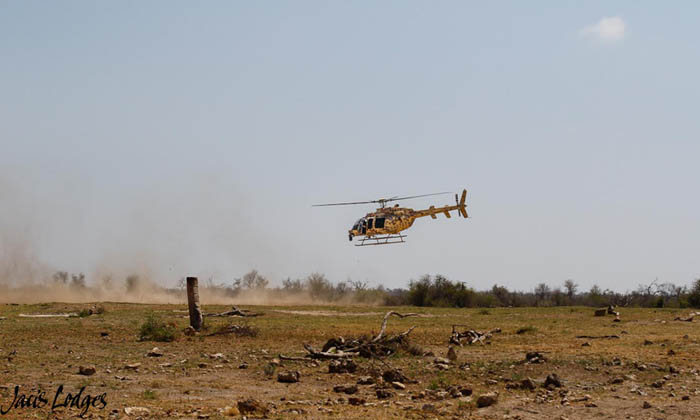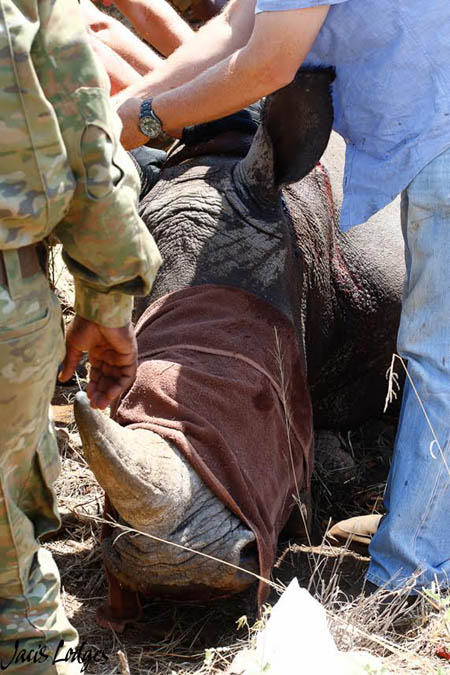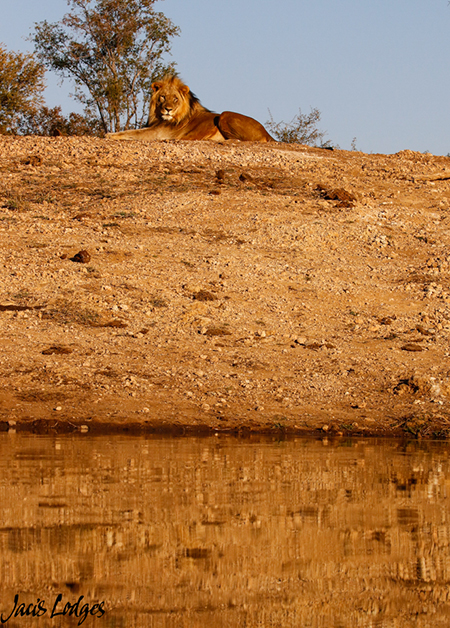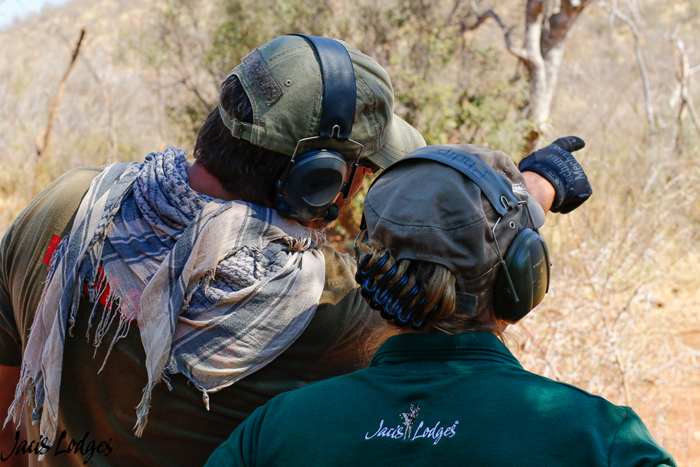The poaching war on rhinos is unfortunately a very real threat to the species. Every day men and women are risking their lives to fight back and save the ones that still remain in the African bush. Last year, at least 1175 rhinos were poached in South Africa alone, and that’s not including the numerous orphaned calves that don’t stand a chance without their mothers. If nothing changes, there’ll be no rhinos left in the wild in ten to fifteen years’ time. A worrying report from a guide out on game drive the other day, told of a young rhino with a suspicious wound. I was able to join the investigation team to find out what had happened. The guide who had found the wounded individual stayed close by the rhino until we arrived, just as the sun was setting.
A worrying report from a guide out on game drive the other day, told of a young rhino with a suspicious wound. I was able to join the investigation team to find out what had happened. The guide who had found the wounded individual stayed close by the rhino until we arrived, just as the sun was setting.
 A worrying report from a guide out on game drive the other day, told of a young rhino with a suspicious wound. I was able to join the investigation team to find out what had happened. The guide who had found the wounded individual stayed close by the rhino until we arrived, just as the sun was setting.
A worrying report from a guide out on game drive the other day, told of a young rhino with a suspicious wound. I was able to join the investigation team to find out what had happened. The guide who had found the wounded individual stayed close by the rhino until we arrived, just as the sun was setting.
The rhino in question was located with some other individuals and was still moving around with them, although far from enthusiastically. It was confirmed that the rhino in question had been shot a few days prior. On closer inspection, an entry and exit wound were visible, meaning that the bullet had passed through and was not lodged in the animal. A few phone calls were quickly made to notify those concerned and to call in a helicopter for the following morning. As it was already getting dark, obviously no helicopter would be sent at this late hour and we could only hope they wouldn’t move too far during the night. The next morning a helicopter arrived with the veterinarian, Gerhardus, landing not far from where we had left the rhinos the previous evening. The helicopter was sponsored by Rhino 911, a recently established non-profit organisation trying to make a difference in the fight against poaching. The helicopter had barely touched the ground before it was propelling towards the last known coordinates of the wounded individual.
The next morning a helicopter arrived with the veterinarian, Gerhardus, landing not far from where we had left the rhinos the previous evening. The helicopter was sponsored by Rhino 911, a recently established non-profit organisation trying to make a difference in the fight against poaching. The helicopter had barely touched the ground before it was propelling towards the last known coordinates of the wounded individual.
 The next morning a helicopter arrived with the veterinarian, Gerhardus, landing not far from where we had left the rhinos the previous evening. The helicopter was sponsored by Rhino 911, a recently established non-profit organisation trying to make a difference in the fight against poaching. The helicopter had barely touched the ground before it was propelling towards the last known coordinates of the wounded individual.
The next morning a helicopter arrived with the veterinarian, Gerhardus, landing not far from where we had left the rhinos the previous evening. The helicopter was sponsored by Rhino 911, a recently established non-profit organisation trying to make a difference in the fight against poaching. The helicopter had barely touched the ground before it was propelling towards the last known coordinates of the wounded individual.
From the air, they started scanning the area in the direction which the rhino had been moving the previous evening. The ground crew were waiting for news from the air. Often injured animals head off on their own and hide in thickets, so it can be quite a challenge to locate them. Within ten minutes we were told that the rhino had been relocated and the pilot (and co-founder of Rhino 911), Nico, proceeded to push the rhino towards one of the roads in the area. Easy access is of paramount importance as it reduces the amount of time the animal needs to be sedated and worked on. We were in luck and not even 100 m from the road, the rhino was darted successfully. We all grabbed water, medical equipment and towels and hurried through the thickets to where it had stopped. The rhino went down moments after we had reached it. Its position was checked in order to ascertain that it could breathe freely. A towel was quickly thrown over its face so as to not stress it unnecessarily and water was poured over its body at regular intervals to keep it from over-heating. It was a relief to see that the bullet had missed anything vital on its way through the body, giving the rhino a fighting chance of survival. The wound was cleaned numerous times, fluids were pumped into the entry and exit holes and then squeezed out again in a stream of pus and antiseptic liquid, to prevent infection. When Gerhardus was satisfied with the cleaning of the wound, antibiotics were administered and the ears notched, to give this individual his “id-number”.
The rhino went down moments after we had reached it. Its position was checked in order to ascertain that it could breathe freely. A towel was quickly thrown over its face so as to not stress it unnecessarily and water was poured over its body at regular intervals to keep it from over-heating. It was a relief to see that the bullet had missed anything vital on its way through the body, giving the rhino a fighting chance of survival. The wound was cleaned numerous times, fluids were pumped into the entry and exit holes and then squeezed out again in a stream of pus and antiseptic liquid, to prevent infection. When Gerhardus was satisfied with the cleaning of the wound, antibiotics were administered and the ears notched, to give this individual his “id-number”. Being this close to a wild rhino and seeing it being helped back to health was an emotional experience that I will never forget. Hopefully, those of us who were there will be able to tell our future guests how we were there when this particular individual was saved and how it spurred us to greater involvement in conservation.
Being this close to a wild rhino and seeing it being helped back to health was an emotional experience that I will never forget. Hopefully, those of us who were there will be able to tell our future guests how we were there when this particular individual was saved and how it spurred us to greater involvement in conservation.
 The rhino went down moments after we had reached it. Its position was checked in order to ascertain that it could breathe freely. A towel was quickly thrown over its face so as to not stress it unnecessarily and water was poured over its body at regular intervals to keep it from over-heating. It was a relief to see that the bullet had missed anything vital on its way through the body, giving the rhino a fighting chance of survival. The wound was cleaned numerous times, fluids were pumped into the entry and exit holes and then squeezed out again in a stream of pus and antiseptic liquid, to prevent infection. When Gerhardus was satisfied with the cleaning of the wound, antibiotics were administered and the ears notched, to give this individual his “id-number”.
The rhino went down moments after we had reached it. Its position was checked in order to ascertain that it could breathe freely. A towel was quickly thrown over its face so as to not stress it unnecessarily and water was poured over its body at regular intervals to keep it from over-heating. It was a relief to see that the bullet had missed anything vital on its way through the body, giving the rhino a fighting chance of survival. The wound was cleaned numerous times, fluids were pumped into the entry and exit holes and then squeezed out again in a stream of pus and antiseptic liquid, to prevent infection. When Gerhardus was satisfied with the cleaning of the wound, antibiotics were administered and the ears notched, to give this individual his “id-number”. Being this close to a wild rhino and seeing it being helped back to health was an emotional experience that I will never forget. Hopefully, those of us who were there will be able to tell our future guests how we were there when this particular individual was saved and how it spurred us to greater involvement in conservation.
Being this close to a wild rhino and seeing it being helped back to health was an emotional experience that I will never forget. Hopefully, those of us who were there will be able to tell our future guests how we were there when this particular individual was saved and how it spurred us to greater involvement in conservation.
As we finished up and all moved out of the way, the vet stayed behind to give the rhino a reversal drug. In no time, it was up and on wobbly legs the rhino moved off in the direction of its companions. I can’t wait to go out on drive again soon in this area, to see if me and my guests can see him and make sure he is doing well after his horrific ordeal.
If any readers or guests would like to get involved or donate much needed funding to the conservation efforts that take place in Madikwe Game Reserve they can donate to the Madike Concessionaires Forum. This fund is used for the reserve for Anti Poaching work, treating animal emergencies (such as the one we blogged on) and all the other incredible conservation work being done.
/A
/A



















